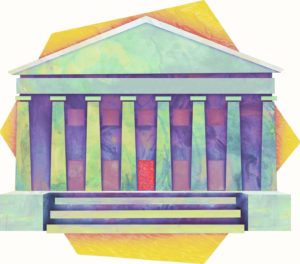This lesson is based on the Annenberg Classroom video that explores the evolution of the free press doctrine, Freedom of the Press: New York Times v. United States.
‘Supreme Law of the Land’: Supremacy Clause
In this lesson, students will explore the origins and evolution of the supremacy clause. How are conflicts between federal and state power resolved?

Understanding the Confrontation Clause
In this lesson, students will explore the fundamental reasons for the confrontation clause of the Sixth Amendment. Students will engage in a simulation and identify the history and evolution of the confrontation clause.
Your Right to Remain Silent: Miranda v. Arizona
This lesson explores the landmark Supreme Court case that made law enforcement the protectors of individual liberty where people are most vulnerable – in the interrogation room.
Making Our Fourth Amendment Right Real: Mapp v. Ohio
This lesson explores the landmark Supreme Court decision that makes state governments also responsible for protecting our Fourth Amendment right. With the exclusionary rule, this right becomes real for all of us.
Jury Selection on Trial
In this lesson, students learn about the process used for jury selection and how the role and responsibilities of government in civil and criminal jury trials are viewed by the Supreme Court. They also reflect on the democratic values, principles, and dispositions of character working behind the scenes.
Jury Service: Our Duty and Privilege as Citizens
In this lesson, students learn about the importance, history, and constitutional foundations of jury service. They become familiar with federal and state juror questionnaires and jury summonses.
Judicial Independence: Essential, Limited, Controversial
In this lesson, students learn about the role of an independent judiciary in the United States. Through a cooperative learning jigsaw activity, they focus on operational differences, essential functions, limited powers, and controversial issues.
Freedom of Speech: Finding the Limits
In this lesson students gain insight into the many challenges involved in defining and protecting free speech. They also learn about principles that come from U.S. Supreme Court decisions, such as Tinker v. Des Moines Independent Community School District and Morse v. Frederick, and case law that are applied to define the limits for us today.
Equal Justice Under Law: Yick Wo v. Hopkins
This lesson teaches about the cause-and-effect relationships between historical events and the development of constitutional principles that protect the rights of all people in America today.
The Power of One Decision: Brown v. Board of Education
Through the lesson, students gain insight into decision-making at the Supreme Court, learn about the people behind the case, construct a persuasive argument, and evaluate the significance of Brown v. Board of Education.
Our Heritage of Liberty: The Bill of Rights
This lesson explores one of the toughest political fights in American history – over a bill of rights for individuals – and the outcome that became a symbol of liberty and freedom in America.
Actions That Changed the Law: Ledbetter v. Goodyear
This lesson tells the law-changing story behind the Lilly Ledbetter Fair Pay Act of 2009. Students gain insight into law-making process and consider how statutory decisions made by the U.S. Supreme Court can prompt better laws.
One School’s Fight: The Making of a Law
Through this lesson, students will learn about the dynamic interconnections of people, principles, and process that are involved in making federal laws.